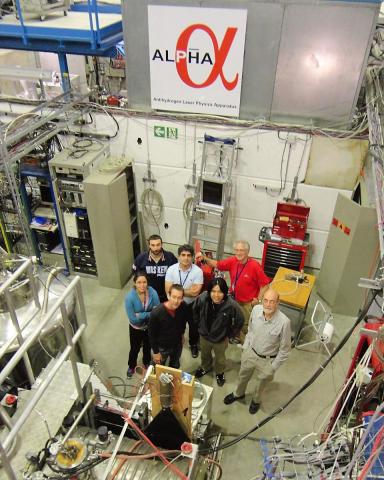
Three experiments, three groundbreaking scientific advances. In their latest paper published online today by the journal Nature, the ALPHA Collaboration at CERN reported on a measurement, spearheaded by their Canadian collaborators, that measured for the first time an intrinsic property of antimatter atoms. In doing so, they’ve provided the world with its first glimpse of an “anti-atomic fingerprint.”
“For decades, scientists have wanted to study the intrinsic properties of antimatter atoms in the hope of finding clues that might help answer fundamental questions about our universe,” says lead author Mike Hayden, a physicist with Simon Fraser University. “In the middle of the last century, physicists were developing and using microwave techniques to study ordinary atoms like hydrogen. Now, 60 or 70 years down the road, we have just witnessed the first-ever microwave interactions with an anti-atom.”
After ALPHA’s previous two measurements demonstrated that antihydrogen (the antimatter partner to normal hydrogen) could be trapped and then held for long periods, the ALPHA team immediately exploited those breakthroughs with another, detecting for the first time the response of trapped antihydrogen to microwaves. So-called “microwave spectroscopy” is used to make ultra-precise measurements of atomic properties.
“This study demonstrates the feasibility of applying microwave spectroscopy to fiendishly difficult-to-handle anti-atoms,” says co-author Walter Hardy from the University of British Columbia. “ALPHA is about to enter an intensive upgrade phase that promises to create an ever-clearer picture of the inner structure of anti-matter atoms.” The ultimate goal is a precise measurement of antihydrogen’s atomic properties to compare them to the very well-known properties of normal hydrogen. Any discrepancy will yield invaluable information for why the universe is dominated by normal matter, while the anti-matter has all but disappeared.
This latest breakthrough was driven by the Canadian contributors to the ALPHA collaboration, led by Professors Hayden and Hardy. Hardy and Hayden designed the apparatus for this latest experiment, working closely with PhD candidates Mohammad Ashkezari of SFU and Tim Friesen from the University of Calgary (under the tutelage of Professor Robert Thompson). Meanwhile researchers from TRIUMF and York University, led by ALPHA-Canada spokesperson Makoto Fujiwara and Professor Scott Menary, respectively, teased faint signals from a sophisticated detector system, pinpointing matter-antimatter annihilation events.
ALPHA Collaboration spokesperson Jeffrey Hangst of Aarhus University pointed out, “Hydrogen is the most abundant element in the universe, and we understand its structure extremely well. Now we can finally begin to coax the truth out of antihydrogen. Are they different? Today we can confidently say “time will tell”.”
- By Marcello Pavan, Outreach Coordinator, TRIUMF
